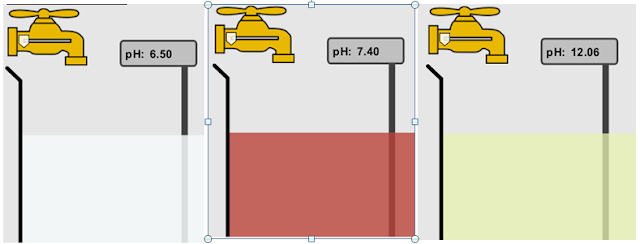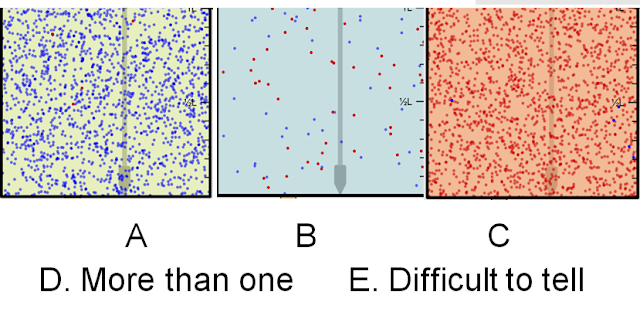1. Run the Build an Atom simulation http://phet.colorado.edu/en/simulation/build-an-atom and build a neutral lithium atom and a neutral boron atom. Take a picture, or a screen shot, of these two atoms and place them on your blog. List the number of protons, neutrons and electrons for each. Also look up and post the density for each of the elements on your blog.
 |
| Protons - 3, Neutrons - 4, Electrons - 3, Density - 0.53 g.cm -3 at 20 °C |
 |
| Protons - 5, Neutrons - 5, Electrons -5, Density -
2.3 g.cm-3 at 20°C |
2. Define density and the equation for density and post on your blog.
Density can be defined as mass or weight per unit of volume, the equation to find density is:
 |
| ρ is the density, m is the mass, and V is the volume |
3.
Run the Density simulation http://phet.colorado.edu/en/simulation/density and complete one(your choice) of the prepared Teaching Ideas and post your results on your blog. The activity you choose should be one of the student intended activities.
PhET- Density
Activity- Funsheet
Custom Section Name_____________
|
Material
|
Mass (kg)
|
Volume (L)
|
Density (kg/L)
|
Does it Float?
|
|
Styrofoam
|
59
|
100.59
|
1
|
Yes
|
|
Wood
|
1.59
|
101.59
|
1
|
Yes
|
|
Ice
|
3.64
|
103.64
|
1
|
Yes
|
|
Brick
|
7.93
|
103.97
|
1.99
|
No
|
|
Aluminum
|
10.71
|
103.97
|
2.69
|
No
|
1.
In the custom setting, choose the ‘My Object’ option
in the material drop down box. Set the
mass of your object to 4 kg. Adjust the volume
to find the minimum volume needed to make the object float.
Volume______4.01_____ Density______.9975_
2.
How does the density of a large piece of aluminum
compare to a small piece?
1 kg – 100.37 2.702702702702703
10 kg – 103.70 2.702702702702703
They are exactly the same, because they are already both completely emerged in water because of their density the volume can't go up any higher.
Same Mass Section
|
Material
|
Mass (kg)
|
Volume (L)
|
Density (kg/L)
|
Does it Float?
|
|
Blue
|
5
|
105.00
|
1
|
No
|
|
Yellow
|
5
|
105.00
|
1
|
Yes
|
|
Green
|
5
|
102.50
|
2
|
No
|
|
Red
|
5
|
101.25
|
4
|
No
|
Same Volume Section
|
Material
|
Mass (kg)
|
Volume (L)
|
Density (kg/L)
|
Does it Float?
|
|
Blue
|
6
|
105.00
|
1.2
|
No
|
|
Yellow
|
8
|
105.00
| 1.6 |
No
|
|
Green
|
4
|
104.00
|
1
|
Yes
|
|
Red
|
2
|
102.00
|
1
|
Yes
|
Same Density Section:
3. Calculate the
density of the blue object in this section.
Mass
____3.00______ Volume______103.75_________
Density______0.2133_______
4. Explain why both
the yellow and red objects float when they have different sizes.
Mystery Section:
5. Before you start,
pick an object that you think will float.
_____Blue B____________
Pick an object
that you think will sink. ______Purple
E______________
|
Material
|
Mass (kg)
|
Volume (L)
|
Density (kg/L)
|
Does it Float?
|
|
A
|
65.14
|
103.38
|
0.6301025343393306
|
No
|
|
B
|
.64
|
100.64
|
0.0063593004769475
|
Yes
|
|
C
|
4.08
|
104.08
|
0.0392006149116065
|
Yes
|
|
D
|
3.10
|
103.10
|
0.0300678952473327
|
Yes
|
|
E
|
3.52
|
101.00
|
0.0348514851485149
|
No
|
6. In the Custom
section describe the difference between how Styrofoam and ice
floated. Also explain why you think this is the case?
The Styrofoam floated mostly above the water, because its
material is much less sense than water, while the Ice floated mostly below the
water level because Ice is water, but in a more dense form.
7. In the Mystery
Section, click on the “Show Table” button.
What is the most dense
object on the
list? Write its density as well.
Lead, 19.3 is leads density.
8. List something you
learned from this activity.
I learned that with objects looks are not always correct, just because an
object is tiny does not mean it will float and be light, whereas just because an
object is large does not mean it will be heavy and sink.
4. Complete the Mystery Blocks activity on the Density simulation. Post on your blog the data you collected (mass, volume, and density) and the identification of the material and the known density.
|
Material
|
Mass (kg)
|
Volume (L)
|
Density (kg/L)
|
Does it Float?
|
Object and known mass
|
|
A
|
65.14
|
103.38
|
19.28
|
No
|
Gold
19.3
|
|
B
|
.64
|
100.64
|
1
|
Yes
|
Water
1
|
|
C
|
4.08
|
104.08
|
1
|
Yes
|
Water
1
|
|
D
|
3.10
|
103.10
|
1
|
Yes
|
Water
1
|
|
E
|
3.52
|
101.00
|
3.52
|
No
|
Diamond
3.53
|
5. Identify and post on your blog the Science Standards that could be met through these activities completed in Activity 5
A.4.3 When investigating a science-related problem, decide what data can be collected to determine the most useful explanations
C.4.2 Use the science content being learned to ask questions, plan investigations, make observations, make predictions, and offer explanations
D.4.5 Construct simple models of what is happening to materials and substances undergoing change, using simple instruments or tools to aid observations and collect data






























